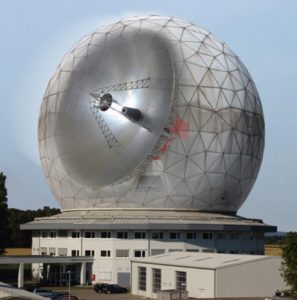Uncontrollable flying objects in the Earth‘s orbit are an enormous risk for active satellites and for spacecraft in general. Since April 2012, the European environmental satellite ENVISAT has also been adrift in orbit. Now, the Fraun-hofer Institute for High Frequency Physics and Radar Techniques FHR has developed pioneering methods to precisely determine the attitude rotation of malfunctioning satellites and, thus, to support de-orbiting missions in the future.

© Photo Fraunhofer FHR
Fraunhofer FHR‘s space observation radar TIRA.
The ENVISAT environmental satellite is one of the largest spacecraft to ever have been put into orbit by ESA. ENVISAT, which cost 2.3 billion euro and weighs nearly eight tons, was launched in 2002 and reliably monitored the Earth’s climate, oceans and land surfaces until 2012 when contact was lost. The Earth-observ¬ing satellite is orbiting at an altitude of approximately 800 km – a region of the Earth’s orbit with a high density of space objects. Space junk is a major problem in low-orbit space flight. Now, ENVISAT’s uncontrolled flight could potentially lead to collisions with active satellites and other space craft,” Dr. Ing. Delphine Cerutti-Maori, Speaker Business Unit Space at Fraunhofer FHR, points out. ”Moreover, there is further risk potential, because collisions can lead to the formation of new debris, which in turn could collide with other objects – a dangerous snowball effect.”
Support for a safe de-orbiting
In order to cope with this issue, ESA is currently looking for solutions to put ENVISAT into a lower orbit and to eventually let the satellite securely burn up when re-entering the Earth’s atmosphere. However, these ”de-orbiting missions” can only be successful if the satellite’s attitude motion parameters can be determined correctly. Only then can it be determined which method is to be used to capture the satellite. The team of researchers at the Fraunhofer FHR offer support for future de-orbiting missions.
”Our TIRA radar combines Ku band imaging radar and L band tracking radar. This system offers the unique possibility to image space objects at high resolutions by using ISAR techniques,” Dr. Ing. Ludger Leushacke, Head of Depart¬ment Radar for Space Observation at Fraunhofer FHR explains. ”In contrast to optical systems, our radar system offers decisive advantages: complete independence from weather conditions, day and night use, as well as an image resolution, which is completely independent of the distance of the object. In addition, we can determine the rotational speed of fast rotating objects, such as ENVISAT, and of slow rotating objects.”
The radar raw data of ENVISAT recorded with TIRA are processed and evaluated using special methods, which were devel¬oped at Fraunhofer FHR in recent years.
Long-term analysis of ENVISAT’s rotation
High-resolution radar images are generated using the relative rotation of the observed object to the stationary radar system. The object is illuminated by different aspect angles. However, the cross-range scaling in the radar image depends on the actual rotational speed, which has to be obtained from the data. ”In order to address this issue, which occurs during image processing, our team of experts has developed a method that uses wire grid models of the objects to properly estimate the cross-range scaling,” explains Cerutti-Maori. »For this purpose, a wire grid model is projected onto different images of a passage. The rotational vector can be reliably estimated through the temporal development of several projections during the object’s passage. ”
To analyse the long term development of ENVISAT’s motion, we were able to use observations from the period between 2011, i.e. shortly before the contact with the satellite was lost, and 2016. During its regular mission, ENVISAT was rotating slowly at about 0.06°/s, which corresponds to one revolution per Earth orbit. Shortly after the connection had been lost on April 8, 2012, it could be observed that the rotation rate had increased to almost 3°/s, or about 45 revolutions per Earth orbit. As the increase was gradual and not sudden, the researchers at Fraunhofer FHR concluded that this was not due to a collision with other objects.
However, a slowing of the speed of rotation has been observed since mid-2013. At the end of 2016 it was about 1.6°/s. ”Our investigations could make a significant contribution to support the future removal of the damaged ENVISAT if ESA decides to do so,” says Leushacke.
”The image-based reconnaissance methods developed at Fraunhofer FHR are currently unique in the world and are ideal for analysing the orientation and rotation of space objects and for predicting their long-term development in a reliable manner. In addition, they can be used to efficiently investigate a potential external damage to satellites.”
Source: Fraunhofer Institute for High Frequency Physics and Radar Techniques FHR